Related Research Articles
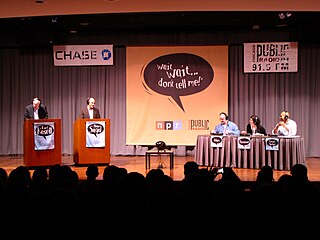
A panel show or panel game is a radio or television game show in which a panel of celebrities participates. Celebrity panelists may compete with each other, such as on The News Quiz; facilitate play by non-celebrity contestants, such as on Match Game and Blankety Blank; or do both, such as on Wait Wait Don't Tell Me. The genre can be traced to 1938, when Information Please debuted on U.S. radio. The earliest known television panel show is Play the Game, a charades show in 1946. The modern trend of comedy panel shows can find early roots with Stop Me If You've Heard This One in 1939 and Can You Top This? in 1940. While panel shows were more popular in the past in the U.S., they are still very common in the United Kingdom.
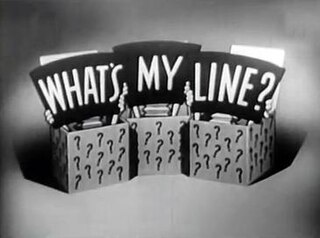
What's My Line? is a panel game show that originally ran in the United States on the CBS Television Network from 1950 to 1967, originally in black and white and later in color, with subsequent U.S. revivals. The game uses celebrity panelists to question contestants in order to determine their occupation, i.e. their "line of work". The majority of the contestants were from the general public. However, there was one weekly celebrity "mystery guest" for which the panelists were blindfolded. It is on the list of longest-running U.S. primetime network television game-shows. Originally moderated by John Charles Daly and most frequently with regular panelists Dorothy Kilgallen, Arlene Francis, and Bennett Cerf, What's My Line? won three Emmy Awards for "Best Quiz or Audience Participation Show" in 1952, 1953, and 1958 and the Golden Globe Awards for Best TV Show in 1962.
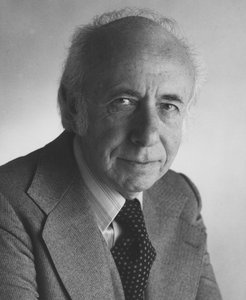
Morton Gould was an American composer, conductor, arranger, and pianist.
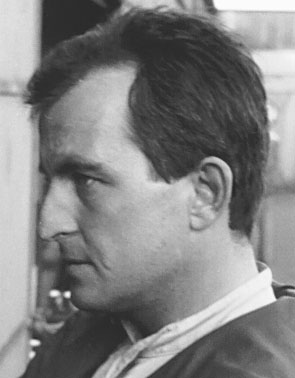
Ludovico Scarfiotti was a Formula One and sports car driver from Italy. Just prior to entering Formula One, he won the 1963 24 Hours of Le Mans for Ferrari. He later participated in 12 World Championship Formula One grands prix, and many non-championship races. He won one World Championship race, and scored a total of 17 championship points. A motor sports competitor for a decade, Scarfiotti won the 1962 and 1965 European Hillclimb Championship. He was proclaimed Italy's best driver in both 1962 and 1965.
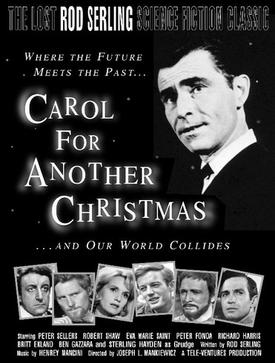
Carol for Another Christmas is a 1964 American TV movie, written by Rod Serling as a modernization of Charles Dickens' 1843 novella A Christmas Carol and a plea for global cooperation. It was the first in a planned series of television specials developed to promote the United Nations and educate viewers about its mission. Originally televised on the American Broadcasting Company (ABC) network on December 28, 1964, it was not shown again for 48 years, until Turner Classic Movies (TCM) broadcast it on December 16, 2012.
ABC Daytime is a division responsible for the daytime programming block on the ABC Network and syndicated programming. The block has historically encompassed soap operas, game shows and talk shows.
James Thomas Aubrey Jr. was an American television and film executive. As president of the CBS television network from 1959 to 1965, with his "smell for the blue-collar," he produced some of television's most enduring series on the air, including Gilligan's Island and The Beverly Hillbillies.

Hawk is a crime drama series starring Burt Reynolds, which aired on ABC from September 8, 1966 to December 29, 1966. The Screen Gems series was Reynolds' first starring role in a television series since leaving Gunsmoke the previous year.

Death of a Salesman is a 1966 American made-for-television film adaptation of the 1949 play of the same name by Arthur Miller. It was directed by Alex Segal and adapted for television by Miller. It received numerous nominations for awards, and won several of them, including three Primetime Emmy Awards, a Directors Guild of America Award and a Peabody Award. It was nominated in a total of 11 Emmy categories at the 19th Primetime Emmy Awards in 1967. Lee J. Cobb reprised his role as Willy Loman and Mildred Dunnock reprised her role as Linda Loman from the original 1949 stage production.
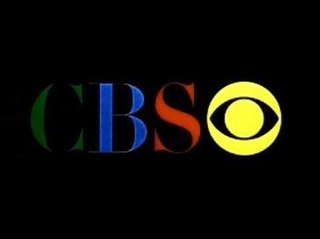
CBS Thursday Night Movie was the network's first venture into the weekly televising of then-recent theatrical films, debuting at the start of the 1965–1966 season, from 9:00 to 11 p.m.. CBS was the last of the three U.S. major television networks to schedule a regular prime-time array of movies. Unlike its two competitors, CBS had delayed running feature films at the behest of the network's hierarchy. Indeed, as far back as 1960, when Paramount Pictures offered a huge backlog of pre-1948 titles for sale to television for $50 million, James T. Aubrey, program director at CBS, negotiated with the studio to buy the package for the network. Aubrey summed up his thinking this way: "I decided that the feature film was the thing for TV. A $250,000 specially-tailored television show just could not compete with a film that cost three or four million dollars." However, the network's chairman, William Paley, who considered the scheduling of old movies "uncreative", vetoed the Paramount transaction.
The United Nations television film series was a series of American television films planned and developed in the 1960s for the purpose of promoting the United Nations (UN) and educating television viewers about its work. Although six films were originally planned only four were broadcast, all by the American Broadcasting Company (ABC) network between December 1964 and April 1966.
In 1960, ABC returned to baseball broadcasting with a series of late-afternoon Saturday games. Jack Buck and Carl Erskine were the lead announcing crew for this series, which lasted one season. ABC typically did three games a week. Two of the games were always from the Eastern or Central Time Zone. The late games were usually San Francisco Giants or Los Angeles Dodgers' home games. However, the Milwaukee Braves used to start many of their Saturday home games late in the afternoon. So if the Giants and Dodgers were both the road at the same time, ABC still would be able to show a late game.
From 1965 through 1975, in addition to the Saturday night game on CBC, Hockey Night in Canada also produced and broadcast a Wednesday night game on CTV, CBC's privately owned competitor; beginning in the 1975–76 NHL season, these midweek games would begin to be broadcast by local stations.
Since the 1960s, all regular season and playoff games broadcast in the United States have been aired by national television networks. When the rival American Football League (AFL) began in 1960, it signed a 5-year television contract with ABC. This became the first ever cooperative television plan for professional football, through which the proceeds of the contract were divided equally among member clubs. ABC and the AFL also introduced moving, on-field cameras, and were the first to have players "miked" during broadcast games. As the AFL also had players' names stitched on their jerseys, it was easier for both TV viewers and people at the games to tell who was who.
"Target for Three" was an American television play broadcast live on October 1, 1959, as part of the CBS television series, Playhouse 90. It was the first episode of the fourth season of Playhouse 90 and the 118th episode overall.
"Misalliance" was an American television play broadcast live on October 29, 1959, as part of the CBS television series, Playhouse 90. It was the third episode of the fourth season of Playhouse 90 and the 120th episode overall.
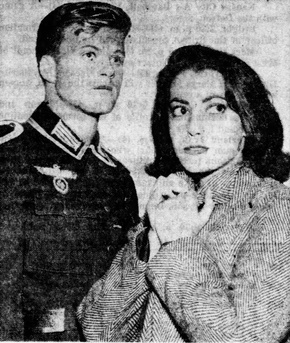
"In the Presence of Mine Enemies" was an American television play broadcast on May 18, 1960. It was the 16th episode of the fourth season of the CBS television series Playhouse 90, and also the final broadcast in the show's four-year run.

Victoria Regina is an American historical drama television film that aired on NBC on November 30, 1961, as part of the anthology series Hallmark Hall of Fame. The production, covering 60 years in the life of Queen Victoria, was nominated for seven Primetime Emmy Awards, winning Program of the Year, Outstanding Single Performance by an Actress in a Leading Role, and Outstanding Performance in a Supporting Role by an Actress.
References
- 1 2 Adams, Val (23 May 1965). Drivers' Test At Home, The New York Times (paywall)
- ↑ Biggers, Buck (28 March 1977). NBC Picks Mayday for test on survival, San Bernardino Sun
- ↑ McKinlay, Archibald (13 November 2011). Rooney was one of a kind - not unusual at CBS, The Times of Northwest Indiana
- ↑ Wolhandler, Joe. From Zero to 31,000,000 - Building an Audience For "The National Drivers' Test", Public Relations Journal, Vol. 21, No. 8, August 1965, pp. 18-19
- ↑ Lowry, Cynthia (25 June 1965). Les Crane Is Getting Another Chance on TV, Ogdensburg Journal (Associated Press story)
- ↑ Lowry, Cynthia (26 May 1965). Drivers' Test Intention Good; Execution Fuzzy, Ogdensburg Journal (Associated Press)
- ↑ (19 May 1966). Flash, Duchesne Eagle
- ↑ Lowry, Cynthia (25 May 1966). Second CBS Drivers Test Entertaining, Informative, Santa Cruz Sentinel (Associated Press)
- ↑ Gould, Jack (24 May 1967). TV: Quiz for Motorists - 3d C.B.S. Drivers Test Again Stresses Precautions That Might Cut Deaths, The New York Times , p. 95
- ↑ Second Chance, Safety Review (Vol. 24, No. 12, Dec. 1967), p. 8 (reporting that the 1967 test was being rebroadcast on December 5, 1967)
- ↑ The National Drivers' Test, Peabodyawards.com
- ↑ Adams, Val (6 December 1965). C.B.S. To Present Health Test Next, The New York Times (paywall) ("Viewers who failed 'The National Drivers Test' or 'The National Citizenship Test' will have another chance when the Columbia Broadcasting System televises 'the National Health Test' on Jan. 13 from 10 to 11 P.M.")
- ↑ Gould, Jack (24 November 1965). TV: An Absorbing Test on Citizenship, The New York Times (paywall)